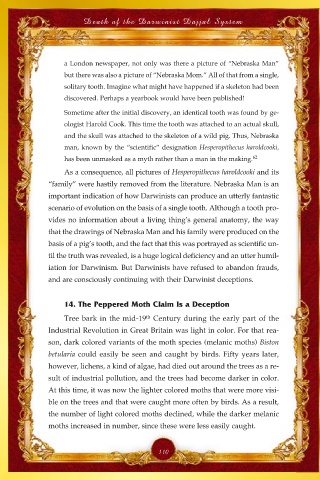Page 112 - Death of the Darwinist Dajjal System
P. 112
Death of the Darwinist Dajjal System
a London newspaper, not only was there a picture of “Nebraska Man”
but there was also a picture of “Nebraska Mom.” All of that from a single,
solitary tooth. Imagine what might have happened if a skeleton had been
discovered. Perhaps a yearbook would have been published!
Sometime after the initial discovery, an identical tooth was found by ge-
ologist Harold Cook. This time the tooth was attached to an actual skull,
and the skull was attached to the skeleton of a wild pig. Thus, Nebraska
man, known by the “scientific” designation Hesperopithecus haroldcooki,
has been unmasked as a myth rather than a man in the making. 62
As a consequence, all pictures of Hesperopithecus haroldcooki and its
“family” were hastily removed from the literature. Nebraska Man is an
important indication of how Darwinists can produce an utterly fantastic
scenario of evolution on the basis of a single tooth. Although a tooth pro-
vides no information about a living thing’s general anatomy, the way
that the drawings of Nebraska Man and his family were produced on the
basis of a pig’s tooth, and the fact that this was portrayed as scientific un-
til the truth was revealed, is a huge logical deficiency and an utter humil-
iation for Darwinism. But Darwinists have refused to abandon frauds,
and are consciously continuing with their Darwinist deceptions.
14. The Peppered Moth Claim Is a Deception
th
Tree bark in the mid-19 Century during the early part of the
Industrial Revolution in Great Britain was light in color. For that rea-
son, dark colored variants of the moth species (melanic moths) Biston
betularia could easily be seen and caught by birds. Fifty years later,
however, lichens, a kind of algae, had died out around the trees as a re-
sult of industrial pollution, and the trees had become darker in color.
At this time, it was now the lighter colored moths that were more visi-
ble on the trees and that were caught more often by birds. As a result,
the number of light colored moths declined, while the darker melanic
moths increased in number, since these were less easily caught.
110

